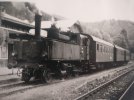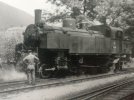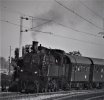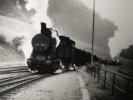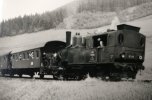70014IronDuke
Established Member
- Joined
- 13 Jun 2015
- Messages
- 3,701
Note: Taken out of this thread
https://www.railforums.co.uk/thread...y-post-world-war-2.225957/page-2#post-5449225
As I thought the Austrian-rail content might be of importance to later researchers.
Quote Reply
Report
Joined 6 Dec 2015 Messages 2,486
The above-prophesied horrid fate came to be at last, in the late 1980s (a long time after the end of steam) -- though with some parts of the system surviving -- including for passenger traffic; to the best of my knowledge, some still active at the present day.
Last edited: Today at 02:11
https://www.railforums.co.uk/thread...y-post-world-war-2.225957/page-2#post-5449225
As I thought the Austrian-rail content might be of importance to later researchers.
70014IronDuke said:
One of the (for me) great advantages of being a railway/steam - photographer/enthusiast back at the end of steam in the UK and taking up the quest of chasing steam on the European continent is that it took one to places few others travelled.
Thus it was that I ventured to Nieder Osterreich in 1972-3. It was certainly a long time after Bryan Morgan, of that there is no doubt, but - and I hope I am not allowing historical knowledge gained later to cloud my memories - but even in 1973, that is 18 years after the Soviet withdrawal from the region north of Vienna, one could still feel the presence of this occupation.
The country people were also amazingly friendly: I would be walking down a road into a village after trying to photograph an OBB 2-8-2T (was it the 91 class? Or 93?) on some vague branch line working and some 55-year old local would spend 2 minutes asking who the heck I was before inviting me in for coffee or Spritze - and maybe a sandwich or lunch.
I am sure that today, these areas are mostly absorbed by the Vienna agglomeration and have become immune to the odd stranger, but back then, they retained their provincial roots, and a foreigner wandering into their midst was, once 'cleared' as ok, was very much welcomed.
Click to expand...
The 93's were the large 2-8-2 tanks and were quite common on non-electrified secondary lines. The 91's were ancient 2-6-0 tanks which by 1970 when I took this photo were confined to the Neuberg branch because of their light weight.70014IronDuke said:
One of the (for me) great advantages of being a railway/steam - photographer/enthusiast back at the end of steam in the UK and taking up the quest of chasing steam on the European continent is that it took one to places few others travelled.
Thus it was that I ventured to Nieder Osterreich in 1972-3. It was certainly a long time after Bryan Morgan, of that there is no doubt, but - and I hope I am not allowing historical knowledge gained later to cloud my memories - but even in 1973, that is 18 years after the Soviet withdrawal from the region north of Vienna, one could still feel the presence of this occupation.
The country people were also amazingly friendly: I would be walking down a road into a village after trying to photograph an OBB 2-8-2T (was it the 91 class? Or 93?) on some vague branch line working and some 55-year old local would spend 2 minutes asking who the heck I was before inviting me in for coffee or Spritze - and maybe a sandwich or lunch.
I am sure that today, these areas are mostly absorbed by the Vienna agglomeration and have become immune to the odd stranger, but back then, they retained their provincial roots, and a foreigner wandering into their midst was, once 'cleared' as ok, was very much welcomed.
Click to expand...
Attachments
Quote Reply
Report
Calthrop
Established Member
Joined 6 Dec 2015 Messages 2,486
With feeling here, of "permission / indulgence" for a bit of what an associate of ours calls "spottery wibble" (as opposed to serious socio-political analysis): fairly closely north-north-east of Vienna -- featuring indeed in strength until late in Austria's steam era, the class 93 2-8-2Ts -- was a wonderful secondary-line system. My only first-hand experience of it was an unforgettable day in summer 1970: for me, utter delight. About the same time as @70014IronDuke's time spent on it: the late lamented Continental Railway Journal wrote of it: "The whole dense network of lightly-trafficked railways in these thinly-populated regions is well worth a visit for its unique branch-line atmosphere. Many trains are mixed, and consist of perhaps two four-wheeled coaches followed by any number of wagons; the schedules are very slow, but often not slow enough to allow for the protracted shunting at wayside stations which gives passengers (never, it seems, more than a handful) rides over quite long sidings, and ample opportunity for photography. The network would probably not survive five minutes if Austria were ever to appoint a Beeching."52290 said:
The 93's were the large 2-8-2 tanks and were quite common on non-electrified secondary lines. The 91's were ancient 2-6-0 tanks which by 1970 when I took this photo were confined to the Neuberg branch because of their light weight.
The above-prophesied horrid fate came to be at last, in the late 1980s (a long time after the end of steam) -- though with some parts of the system surviving -- including for passenger traffic; to the best of my knowledge, some still active at the present day.
Last edited: Today at 02:11
Last edited:

